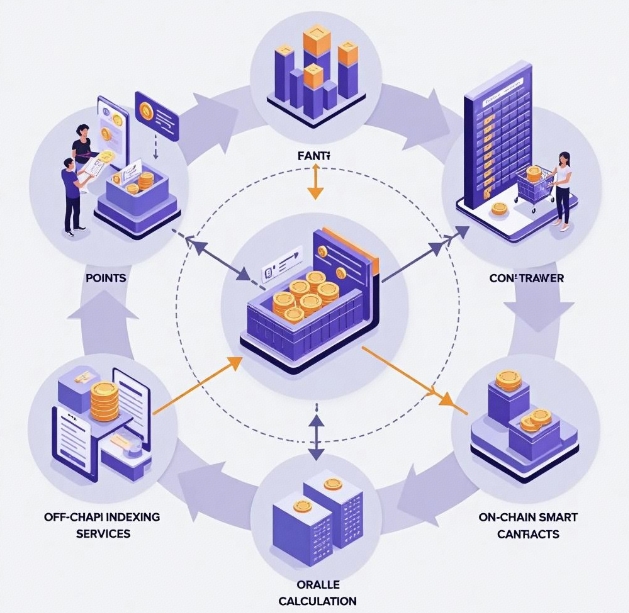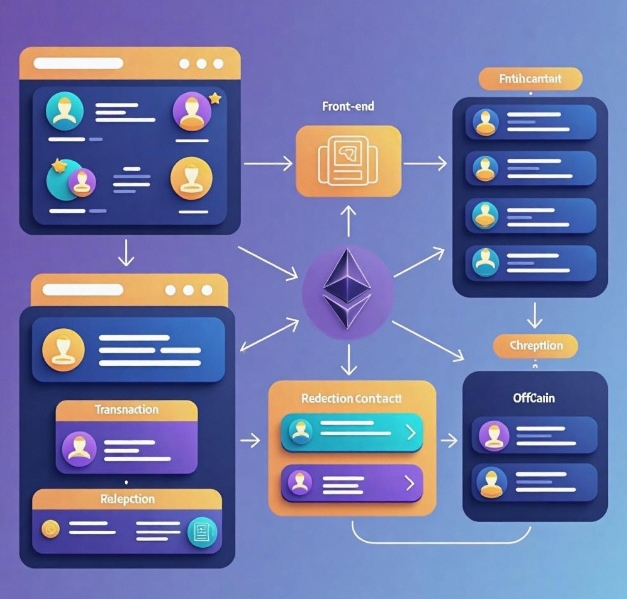How can DApp data achieve efficient collaboration between on-chain and off-chain?
- latest articles
- 1.DApp Development & Customization: Merging Diverse Market Needs with User Experience 2.Analysis of the Core Technical System in DApp Project Development 3.How to achieve cross-chain interoperability in Web3 projects? 4.How does the tokenization of points reconstruct the e-commerce ecosystem? 5.How to Set and Track Data Metrics for a Points Mall? 6.What is DApp Development? Core Concepts and Technical Analysis 7.Inventory of commonly used Web3 development tools and usage tips 8.Development of a Distribution System Integrated with Social E-commerce 9.Six Key Steps for Businesses to Build a Points Mall System 10.What is DApp Development? A Comprehensive Guide from Concept to Implementation
- Popular Articles
- 1.Future Trends and Technology Predictions for APP Development in 2025 2.Analysis of the DeFi Ecosystem: How Developers Can Participate in Decentralized Finance Innovation 3.From Zero to One: How PI Mall Revolutionizes the Traditional E-commerce Model 4.DAPP Development | Best Practices for Professional Customization and Rapid Launch 5.Recommended by the Web3 developer community: the most noteworthy forums and resources 6.From Cloud Computing to Computing Power Leasing: Building a Flexible and Scalable Computing Resource Platform 7.How to Develop a Successful Douyin Mini Program: Technical Architecture and Best Practices 8.Shared Bike System APP: The Convenient Choice in the Era of Smart Travel 9.How to Create a Successful Dating App: From Needs Analysis to User Experience Design 10.From Design to Development: The Complete Process of Bringing an APP Idea to Life
With the continuous development of blockchain technology, decentralized applications (DApps) have gradually become a core component of the Web3 ecosystem. The rise of DApps has broken the monopoly of traditional centralized platforms over data, but it has also introduced new challenges in data processing—how to achieve efficient collaboration between on-chain and off-chain data while ensuring decentralized security has become a problem that DApp developers must face.
This article will start with the basic architecture of DApps, analyze the characteristics of on-chain and off-chain data, explore the core issues in their collaboration, and, in conjunction with current mainstream technical solutions, provide an in-depth analysis of how DApp data can achieve efficient synergy, thereby promoting the development of decentralized applications towards higher performance and broader application scenarios.
I. Overview of DApp Architecture and Data Structure
1.1 Basic Structure of DApps
DApps, or Decentralized Applications, are applications that run on decentralized networks, most commonly on smart contract platforms like Ethereum. Their core architecture typically includes the following components:
Frontend Interface: The user interaction layer, usually a web or mobile application.
Smart Contract: Business logic deployed on the blockchain.
Off-chain Services: Includes auxiliary functions such as data storage, computation, caching, and querying.
1.2 Characteristics of On-chain Data
On-chain data has the following notable characteristics:
Immutability: Once data is on the chain, it cannot be altered.
Transparency: Anyone can view the data on the chain.
Low Throughput, High Cost: Blockchain transactions have long confirmation times and high fees, making them unsuitable for frequent, large-scale data storage.
1.3 Characteristics of Off-chain Data
In contrast, off-chain data offers greater flexibility:
High Performance: Off-chain systems can handle large volumes of requests quickly.
Low Cost: No on-chain fees are required.
Mutability: Data structures can be modified, deleted, or optimized.
Therefore, DApps often adopt a hybrid architecture combining on-chain and off-chain components: core logic and critical data are stored on-chain, while non-critical data and heavy computation are processed off-chain.
II. Core Challenges in On-chain and Off-chain Collaboration
2.1 Data Consistency Challenges
The data lifecycles on-chain and off-chain differ, making consistency a major challenge. For example, if an on-chain transaction succeeds but the off-chain service fails to synchronize the data, it may lead to data misalignment and frontend display errors.
2.2 Security Issues
Off-chain systems are vulnerable to traditional attack methods (such as SQL injection, DDoS, etc.), and their security is generally lower than that of on-chain systems. Ensuring the trustworthiness of off-chain data is a critical security concern for DApps.
2.3 Real-time Performance and Response Speed
The user experience of DApps heavily depends on response speed. On-chain operations are constrained by block times, while off-chain systems need to provide fast responses and real-time data updates.
2.4 Data Storage Costs and Accessibility
Storing large volumes of data, images, audio, and video directly on-chain would incur significant costs, making reliance on off-chain storage (such as IPFS) necessary. However, ensuring the long-term accessibility of these off-chain resources is also a technical challenge.
III. Technical Solutions for Efficient On-chain and Off-chain Collaboration
3.1 Using Decentralized Storage (e.g., IPFS/Arweave)
Store large files, historical data, images, and other unstructured content on IPFS (InterPlanetary File System) or Arweave, while storing only their hash values on-chain to balance cost and performance. This approach can:
Save on-chain costs
Improve data loading speed
Ensure data verifiability (via hash verification)
For example, an NFT image can be uploaded to IPFS, with only its CID (Content Identifier) stored on-chain.
3.2 Using Oracles to Synchronize Off-chain Information
Oracles act as "bridges" from off-chain to on-chain, bringing real-world data such as weather, prices, and event results into the blockchain in a trustworthy manner. Common oracle services include Chainlink and Band Protocol.
On-chain contracts can call oracle interfaces to synchronize off-chain information in real-time, ensuring data reliability and security.
3.3 Leveraging Layer 2 and Rollups to Enhance Performance
To address the bottlenecks in on-chain computation and storage, many DApps choose to move some computational tasks to Layer 2 networks, such as Optimistic Rollup or ZK Rollup. These solutions batch process transactions off-chain and periodically submit the results to the main chain, achieving:
High TPS (transactions per second)
Lower transaction fees
Consistency in data and state
For example, StarkNet and zkSync are typical representatives of ZK Rollup.
3.4 Establishing Event Monitoring and Caching Mechanisms
The frontend can monitor on-chain events in real-time to capture state changes and use off-chain caching mechanisms (such as Redis or GraphQL services) for preprocessing, optimizing the response speed of the user interface.
The Graph is a powerful off-chain indexing service that quickly responds to frontend data queries by building subgraphs.
3.5 Verifiable Computation
In scenarios with high computational costs and complex logic, computation can be performed off-chain, and the results can be submitted to the chain for verification using zero-knowledge proofs (ZKPs) or other methods. This not only saves resources but also enhances computational trustworthiness.
ZK-SNARK and ZK-STARK are key technologies for achieving trustworthy off-chain computation.
IV. Analysis of Practical Application Cases
4.1 On-chain and Off-chain Collaboration in NFT Platforms
Taking OpenSea as an example, NFT transaction logic and ownership changes are handled on-chain, while images, video content, and user profiles are stored via IPFS or traditional cloud services. Off-chain services provide rich search, recommendation, and user interface experiences, achieving a balance between commercial viability and decentralization.
4.2 Decentralized Exchanges (DEX)
DEXs like Uniswap handle trade matching and asset exchanges entirely on-chain, but process price charts, transaction history, and candlestick analysis off-chain. These data are synchronized in real-time by off-chain services through event monitoring and then made available to the frontend via APIs.
4.3 Liquidation Systems in DeFi Protocols
Liquidation mechanisms in DeFi protocols like Compound and Aave require extremely high real-time performance. They typically use off-chain keeper nodes to monitor market price changes and trigger on-chain liquidations. This design ensures tight coupling between off-chain processing speed and on-chain security mechanisms.
V. Future Development Trends and Considerations
5.1 Data Modularization and Interface Standardization
Future DApps will trend towards modular development, and on-chain and off-chain interfaces will become more standardized. For example, the promotion of protocols like ERC-4337 (Account Abstraction) and EIP-712 (Structured Data Signing) will simplify on-chain and off-chain interactions.
5.2 Smarter Data Collaboration Platforms
With the integration of AI and blockchain, off-chain services can enable intelligent analysis, prediction, and decision-making, providing smarter execution references for on-chain operations, such as AI-driven decentralized risk control and personalized recommendations.
5.3 Data Sovereignty and Enhanced Privacy
The maturity of ZK technology will advance user data privacy protection. DApps will support "verifiable but invisible" data collaboration models, allowing users to participate in on-chain logic without compromising their privacy.
Conclusion
Efficient collaboration between on-chain and off-chain components is key to the successful implementation of DApps. By designing architectures rationally and adopting technologies such as decentralized storage, oracles, and Layer 2, developers can achieve a good balance between security, performance, and cost. As Web3 infrastructure continues to improve, the efficiency of on-chain and off-chain collaboration will keep increasing, driving decentralized applications into broader development spaces.
-

DApp Development & Customization: Merging Diverse Market Needs with User Experience
As blockchain technology matures and becomes more widespread, decentralized appl···
-

Analysis of the Core Technical System in DApp Project Development
With the rapid development of blockchain technology, decentralized applications ···
-

What is DApp Development? Core Concepts and Technical Analysis
With the rapid development of blockchain technology, decentralized applications ···

 Blockchain
Blockchain












